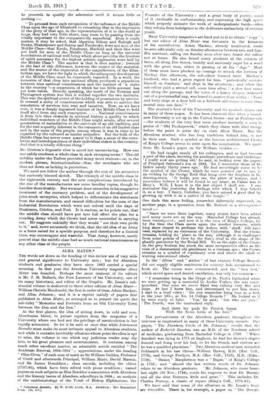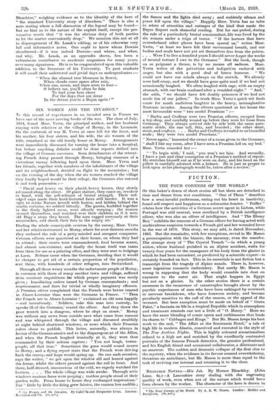ALMA MATER.*
Tax words set down as the heading of this review are of very wide and general significance to University men ; but for Aberdeen students and graduates they have since 1883 carried a special meaning. In that year the Aberdeen University magazine Alma Mater was founded. Perhaps the most eminent of its editors is Mr. J. M. Bulloch, the Poet Laureate of his University, one of its many historians, and editor of the Graphic. Mr. Leask's sub- stantial volume is dedicated to three other editors of Alma Mater— William Christie Macdonald, the first in order of time, Adam Mackay, and Allan Johnson.; and it is a reprint mainly of papers first published in Alma Mater, so arranged as to present (to quote the sub-title) " Memories and Portraits from an Old University Town between the Don and the Dee."
At the first glance, the idea of sitting down, in cold and non- Aberdonian blood, to peruse reprints from the magazine of a University where one had not the privilege of matriculation is but tepidly attractive. So let it be said at once that while Interamna Borealis must make its most intimate appeal to Aberdeen students, and while it contains inevitably allusions whose point the alien is apt to miss, the volume is one which any judicious reader may dip into, to his great pleasure and entertainment. It contains, among much other excellent matter, an admirable article entitled " The Academic Revival, 1864-1914 " ; appreciations, under the heading " Olim Cives," of such men of mark as Sir William Geddes, Professor of Greek and afterwards Principal, William Mints, David Masson, and Sir James Donaldson ; class records, including the oldest (1787-91), which have been edited with pious erudition ; casual papers on such subjects as Miss Braddon's association with Aberdeen and the literary tastes of Aberdeen schoolboys in 1868 ; an analysis of the emblematology of the Tomb of Bishop Elphinstone, the
• Intssrasaxj Bondi*. By W. Keith Leask, M.A. Aberdeen : The Rosemount Pleas. 16s. net.I
Founder of the University ; and a great body of poetry,3 fn:c11 of it creditable in craftsmanship, and expressing the high spirit'- which properly animate the work of undergraduate bards—when they refrain from indulgence in the deliberate melancholy of extreme youth.
Many University magazines are hard put to it to obtain copy ; but one editor of Alma Mater was fortunate in the keenness of his contributors. Adam Mackay, already mentioned, could be seen editorially only on Sunday afternoons between two and four. His assistant, calling one Sunday soon after two, found the editor not at home. He also found many students at the corners of lanes, all along Dee Street, timidly and anxiously eager for a word
with the great man, either in passing or at hie " digs." Most of them must have plucked up courage to attack the fortress of Mackay that afternoon, the sub-editor learned later. Mackay's landlord, who had a great regard for him, " periodically overate himself on Sundays," and slept in the afternoon ; and when tho sub-editor paid a second call, some time after, " a slow foot came out along the passage, and the voice of a heavy sleeper, wakened out of a postprandial nap, was heard to mutter from within : ' Four and forty rings at a door bell on a Sabbath aifterneen is mair than mortal man can face.' "
The student's love of his University and its symbols shines out in many of these pages. It has been observed that when a brand- new University is sot up in the United States—say at Paukapewek —the students of the very first term produce instantly a song in praise of " Old Paukapewek," which they chant with filial energy before the paint is quite dry on their Alma Mater. But the Aberdeen student, who has long traditions behind him, is not in their case. Such a symbol as the famous architectural Crown of King's College seems to seize upon his imagination. We quote from Mr. Leask's paper on Sir William Geddes :- " He had taught nearly all his colleagues, and so had become a part of the place, knowing the academic precedents and traditions. I really now am getting old,' he said, in looking over the paper.; of Principal Selmond's son in 1884, for I remember those of his father nearly thirty years ago.' He had accordingly come to be the symbol of the Crown, which he once pointed out to me, in an etching by Sir George Reid that hung over the fireplace in hi.; drawing-room. ' It holds, you see, the place of honour, and sometimes believe it will be found in my heart, as Calais was in
Mary's. Well, I hope it is the last object I shall see. I can remember like yesterday the feelings with which I first beheld it, as a boy. I fancy, Gulielme, you have missed a good deal by growing up with it as a native of the burgh.' " One finds this same feeling, somewhat differently expressed, on another page, in a quotation from Mr. Bulloch in a retrospective mood :-
"Since we were there together, many stones have been added and many more are on the way. Marisehal College has already been transfigured ' • and now it is the turn of King's College, for by the time the Class meets again the derelict brewery, which long since ceased to perfume the Aulton with draft,' will have been replaced by an extension of the University. But the Crown remains, holding its place in the sun,' although it is challenged from some points of view by the Sun's rival in the shape of the ghastly gasometer by the Broad Hill. To us the sight of the Crown on the grey horizon has much the same recuperative effect as the visit of a rheuxnatioal old gentleman to a German spa ; the Crown remains as a symbol of continuity over and above the clash of warring educational ideals."
In the " fifties " and " sixties " of last century College I3ounds did not supply eligible residences for country lads accustomed to fresh air. The rooms were overcrowded, and the " box bed," which saved space and denied ventilation, was only too common :– -
" I remember being in the Crypt of St. Paul's Cathedral when we were getting up a memorial to Archie Forbes, the war corre- spondent. One man we never liked was talking very fine and large. At last I knew him, and determined to put him down. I said in a loud voice : Do you remember lying four in a bed.
in the year 185–, at No. 14 College Bounds He looked as if he were ready to faint. Yes,' he said ; but who are you ? '
The fourth,' was the unabashed reply.
And there lay gude Sir Patrick Spans With the Scots lords at his feet.
The pervasiveness of the Aberdeen graduate throughout the universe is emphasized in many of these University records. One paper, " The Aberdeen Circle of Dr. Johnson," recalls that the author of Roderick Random was an M.D. of the Northern school of medicine, graduating from Marischal College in 1750. " When Smollett was dying in 1771 at Leghorn, he had his doctor's degree framed and hung over his bed, to let his friends and visitors see he was a qualified physician." Two Aberdeen medical men attended Goldsmith in his last illness—William Hawes, MJ). (Mar. Coll., 1779), and George Fordyce, M.A. (Mar. Coll., 1753), M.D. (Edin., 1758). " Ossian " Macpherson was a " Bajan " of King's College in 1752 ; and " almost the last written words of Dr. Johnson relate to an Aberdeen graduate. Mr. Johnson, who came home last night (16 Nov., 1784), sends his respects to dear Dr. Burney and all the dear Burneys, little and great.' " This includes Dr. Charles Burney, a classic of repute (King's Coll., 1771-81).
We have said that some of the allusions in Mr. Leach's book are recondite. There is, for example, a paper on " The Downie Slauchter," weighing evidence as to the identity of the hero of " the standard University story of Aberdeen." There is also a note stating where a full discussion of the legend may be found— but no hint as to the nature of the exploit itself, except the pro- vocative words that " it was the obvious duty of both parties to let the matter conveniently drop." We mention this not at all in disparagement of Mr. Leask's editing, or of his otherwise very full and informative notes. One ought to know whom Downie slauchtered—if it was indeed Downie—and where, and when, and why. Mr. Leask, as an appendix shows, has been a voluminous contributor to academic magazines for many years, over many signatures. He is to be congratulated upon this valuable addition to the literature of his University. To past students it will recall their unfettered and jovial days as undergraduates :-
"When the almond tree blossoms in flower, When clouds come apace after rain, When sun, moon, and stars seem to lour- 0 believe me, you'll often be fain To find your best cheer For the days that are drear In the dream you're a Bajan again ! "



































 Previous page
Previous page